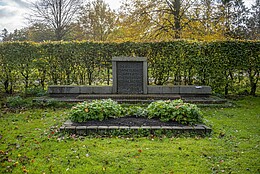Flensburg
In April 1945, several evacuation transports from the Neuengamme concentration camp arrived in Flensburg.
On 20 April 1945, the SS had left the Sandbostel “reception camp” with several hundred prisoners who were "able to march". The prisoners were put on the ship Olga Siemers and taken through the Kiel Canal and across the Baltic Sea on 30 April to Flensburg. Sick prisoners were transferred to a sick bay, while the rest were loaded onto goods cars and transported on by train. However, the train came to stop after just a few kilometres at the Flensburg-Weiche railway station.
The Neuengamme concentration camp had been almost entirely evacuated between 20 and 26 April and the prisoners had been taken to Lübeck. On 29 and 30 April, around 600 more prisoners left Neuengamme in smaller groups. They could no longer reach Lübeck, however, and instead continued on to Flensburg, where they encountered the prisoners from Sandbostel in Flensburg-Weiche. On 4 May, all of the prisoners were taken to Flensburg Harbour and put on board the ship Rheinfels. The prisoners were not liberated by the British until 10 May.
Period
April 1945 to May 1945
Number of Prisoners
-
Kind of Work
-
Labor on Behalf of
-
Location
Directions
Friedenshügel cemetery
Langberger Weg
24941 Flensburg
Germany
Memorial
On 4 June 1950, a memorial stone was placed in the Friedenshügel cemetery in Flensburg by the Association of Resistance Fighters and Victims of the Nazi Regime. Since the 1960s, a monument has stood in the same location which bears the inscription: “Den namenlosen Opfern in Ehrfurcht und Gedenken 1933–1945” (“Dedicated to the nameless victims in reverence and commemoration 1933-1945”). Fifty-eight concentration camp prisoners are buried in the cemetery, only seven of whom are known by name.

